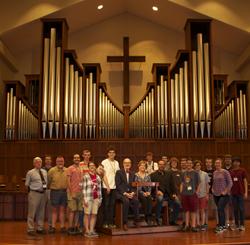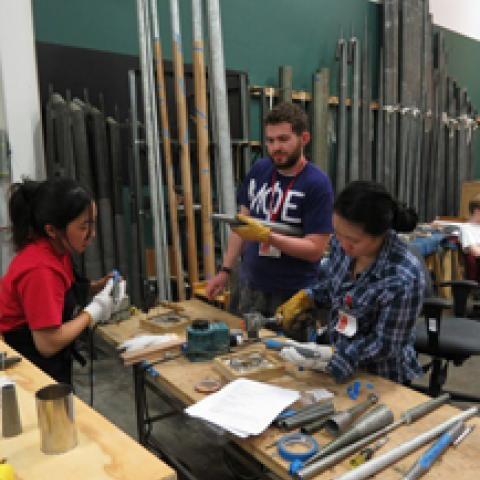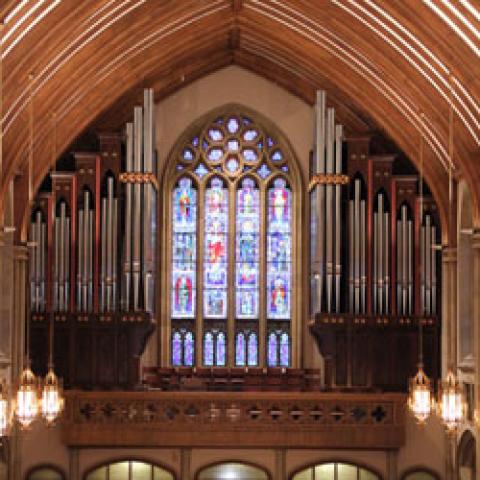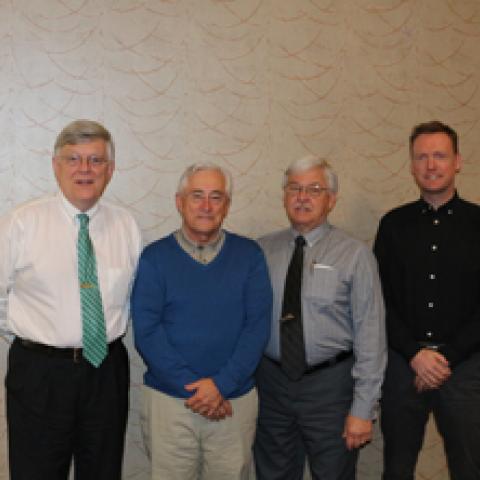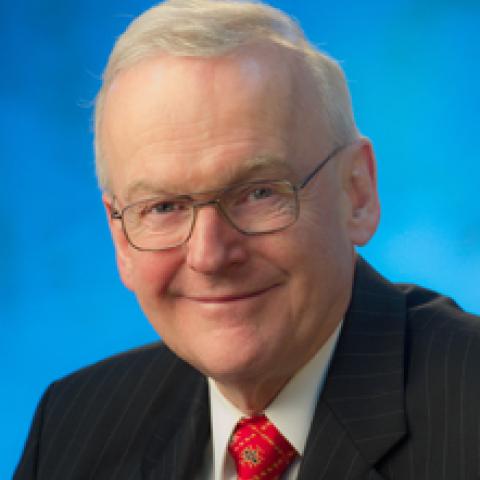Sebastian M. Glück
Tuesday, September 28
Wall sconces taking the form of artillery shells line the nave of the Protestant Cadet Chapel of the United States Military Academy at West Point, home of what began as M.P. Möller’s Opus 1201 of 1911. Now IV/380, it incorporates pipework provided by a list of builders from George Edgar Gress to Aristide Cavaillé-Coll. The sheer size of this instrument may very well be its most American characteristic. Since pipework and divisions are added to this organ, not replaced, the organ is a growing compendium of trends. As an agglutinated scheme built up over the past century, an organ of this size must struggle to put forth a distinctive and identifiable character.
Army Chaplain Scott McChrystal (Colonel) spoke about the organ’s history and role at the academy before introducing organist Craig Williams, organ curator Gary Ferguson, and associate organ curator William Chapman.
Mr. Williams’ opening selection was “The Turning on of the Blowers,” a work for eight switches, featuring over 100 horsepower of turbines. The remainder of his program ran the gamut from a Dvorák symphonic transcription to Georgian miniatures. Following the demonstration-recital, a buffet dinner, complete with carvery, was served at the Officers’ Club overlooking the Hudson River.
Wednesday, September 29
AIO President Charles Kegg presided over the opening of the convention, marked by the first session of the Institute’s annual business meeting. The routine nature of the early morning meeting was offset by a sumptuous breakfast buffet, the first of many lavish and healthy meals planned by this year’s convention committee (Timothy Fink, Sebastian M. Glück, Allen Miller, chairman Edward Odell, Holly Odell, and F. Anthony Thurman).
Historian, musician, and Organ Historical Society Archivist Stephen Pinel’s history of New York organbuilders, “The Orchard in the Apple,” was a polished, well-researched presentation. It was reminiscent of a Burns documentary, the text so focused and the materials so pertinent that one forgot that the images were still, not moving. Pinel’s access to archival material combined with uncompromising production values set a benchmark for future historical lectures, yet it would be difficult to find something more titillating than the nude image of Ernest Martin Skinner that revealed the legend in a most human light.
Mr. Pinel closed with a requiem for our historical organs, imploring us to help preserve what remains. Few heritage instruments survive unaltered in New York City, despite its nearly unrivaled reign as a center of organbuilding during the Industrial Revolution.
Mike Foley, a champion of the service sector of the organbuilding field, captivated attendees with a dynamic presentation that was at once a business lecture, an ethics seminar, and a motivational gathering. “Minding Your Own Business” mixed life lessons with business advice: fix your mistakes before others find them; voice pipes, not opinions; love every pipe organ you see and hear, and your telephone shall ring. Get to know your clients; make sure that they know you, not just your bid. Above all else, eschew cynicism--or find another calling.
Be as precise in the writing of your contracts as in the keeping of your books, no matter how daunting the prospect. Audit your firm, insure your assets, motivate your staff, and enjoy yourself, and surely thy business shall thrive. More organs are serviced and tuned in a year than are built.
As do so many Europeans, AIO member Didier Grassin has such a subtly poetic grasp of the English language that it leaves this writer envious. His engineering degrees retreat to the background as organists and organbuilders alike marvel at the exquisite beauty of the organs he has designed. “The Canon Rules of Good Organ Case Design” explained the emotional/artistic response as essential to the success of the organ case. Neither frivolous nor luxurious, but necessary, the well-dressed pipe organ must embody architecture beyond utility as a critical component of the complete æsthetic experience of seeing, hearing, and touching The King of Instruments.
The shape of the case, its position within the space, and the breaking of planes in the massing are as important as the desired elements of vertical thrust and a strong focal point. Texture and color, from the grain and hue of the timber, to the play of light on carvings and façade pipes, must invite the observer to touch such a creation. Movement, tension, relief, and proportion--the elements of fine painting, sculpture, and architecture--make a great organ case.
Organist and organbuilder Sebastian M. Glück, editor of the Institute’s Journal of American Organbuilding, ended the lecture cycle with “What Goes Where and Why,” an analytical prescription for organ design based upon the demands of the literature we play. Many organs, even very large ones, are ill-equipped or incapable of accurately performing entire segments of the organ literature because consultants, organists, and organbuilders ignore historical treatises, the musical score, and the instruments for which the music was written.
American organ design continues to be plagued by stops at the wrong pitches in the wrong locations, and in some sectors has yet to recover from the misinterpretations of the “Organ Reform Movement” of the last century. The American “Bach organ” of the mid-1960s is strikingly dissimilar to the organ that Bach might have played in the 1730s, and sadly, the average American organ cannot handle French music of any era with real accuracy. The lecture exposed the pitfalls of grab-bag eclecticism, and outlined the elements of scholarship that are contributing to the success of today’s polyglot masterpieces.
Thursday, September 30
The Bedford Presbyterian Church, a carpenter Gothic 1872 building on The Village Green, is home to Martin Pasi’s 2001 II/29 Opus 13, a freestanding, encased organ with mechanical key action. The demonstration-recital was performed by John Lettieri, AAGO. The two manual divisions are of equal size, the Swell essentially an Oberwerk with the addition of an undulant and shutters. With a warm and generous ensemble, punctuated by two differently pungent tierces, the instrument convincingly handles large portions of the literature. The opportunity for AIO members to tour the instrument revealed meticulous craftsmanship and fine materials throughout.
Back in the mid-1960s, when no American organbuilder was good enough for the nation’s most famous concert hall, a very wealthy woman donated a Flentrop organ to New York’s Carnegie Music Hall. Ultimately rejected by a board of experts, the organ languished in storage for a decade before its adoption by The State University of New York at Purchase. There it languishes today, in an immense storage shed at stage left, its “Moderne Neo-Aztec” casework surrounded by acoustically annihilating drapes. Built on an air caster platform, a crew of ten can, in several hours, move it to the main stage for its annual appearance at a Christmas event.
Robert Fertitta played small fragments of various organ works, and we were informed that the organ had been tonally altered by pressure changes, substitution of some stops, and revoicing after taking up residence at Purchase. The instrument’s curator, Peter Batchelder, served as historian, narrator, and supplemental combination action, and it is his quiet diligence and dedication that has kept that instrument working, in tune, and available to students.
Virgil Fox, Frederick Swann, William Sloane Coffin, Robert Hebble, John D. Rockefeller, Jr., Richard Weagly, Anthony A. Bufano--the list of associations is long when it comes to The Riverside Church. Timothy Smith, DMA, now presides over the V/204 instrument, front and back, that still retains much of the flavor of Aeolian-Skinner Opus 1118 of 1947, the famous instrument from which it evolved. The interior surfaces of the large room, in a squatter-than-accurate version of French gothic, have been sealed to provide a fiery acoustic, adding reverberation and a telling upper end to the original sound. Dr. Smith knows this impeccably maintained organ well, and his technical and musical abilities provided a fine demonstration of its capabilities.
A drive down sumptuous Fifth Avenue along Central Park brought us to Temple Emanu-El, the world’s largest Reform synagogue. Our first stop in the large complex was the 270-seat Beth-El Chapel. Sebastian Glück’s 1997 III/34 Opus 5 in the west gallery was demonstrated by one of the temple’s staff organists, Pedro d’Aquino, as a prelude to the panel discussion, “Metropolitan Marvels: Conservation and Curatorial Practices for the Large Urban Pipe Organ.” Panelists were Joseph Dzeda of Yale University and the Thompson-Allen Company, Gary Ferguson of West Point, and Curt Mangel of the Wanamaker (Lord & Taylor) Store in Philadelphia. Mr. Glück, whose firm maintains some of New York City’s large instruments, served as panel moderator.
Our move into the breathtaking sanctuary provided many attendees’ first visit to a synagogue. This vast, mystical space, a blend of Art Deco and Byzantine æsthetics filled with carving, polychrome, mosaic, and stained glass, can be overwhelming. A rare visual treat was the congregation’s famous Succah, erected on the bimah for the festival of Succot. Sebastian Glück’s demonstration-recital included repertoire of all cultures and eras, including two short works he had written specifically for the instrument. The 2003 IV/135 is Glück’s Opus 7, featured in the November 2004 issue of The Diapason, which retains 66 ranks from the temple’s 1928 Casavant Opus 1322. The largest of three pipe organs in the complex, the symphonic instrument’s style can best be described as Anglo-French Romantic Neoclassicism, using special scales and mixture compositions to overcome the acoustical stone that lines the 2,500-seat room.
With nearly 20,000 restaurants in New York City, conventioneers were set free for dinner on the fashionable Upper East Side before returning to the buses.
Friday, October 1
The second half of the Institute’s annual business meeting always includes a presentation on the state of the pipe organ industry by Dr. Robert Ebert of Baldwin-Wallace College. Based upon surveys filled out each year by the AIO membership, trends are tracked in areas ranging from the number of rebuilds, to number of electronic organs replaced by real pipe organs, to the number of new ranks built, to which denominations are investing in pipe organs.
This year’s Open Forum touched upon the AGO’s new Task Force on Digital Inclusiveness. One issue discussed was the pipe organ builder’s responsibility for making the pipes as beautiful as possible, and not leaving the pipe complement of these hybrid instruments to untrained sales agents with no voicing or tonal finishing experience. Many questions arose, especially about whether craftsmen in the Institute should combine their art with short-lived, disposable imitations.
“First Do No Harm,” a panel moderated by Laurence Libin of The Metropolitan Museum of Art, stressed both procedure and ethics. Pipe organ conservators Scot Huntington (OHS Vice President), Joseph Dzeda, and Richard Hamar discussed documentation, techniques, and the increasingly focused ethical mindset of the worldwide restoration community. An instrument’s age is no longer the sole criterion for historical significance. Restorations and alterations must be evident and reversible, and we must learn to stop “fixing” problems that do not exist. Preservation does not equate to paralysis, but we must end the process of ruination in the name of fashion by removing our personal judgments from the project.
Respected consultant and engineer Richard Houghten served as moderator for “Command and Control,” a highly technical panel discussion of advances in the technology and application of solid state pipe organ control systems. Engineers Scott Peterson, Duncan Crundwell, Arthur Young, Allen Miller, and Henry Wemekamp delivered individual presentations before a moderated discussion and questions from the floor.
The convention formally ended with Craig Whitney of The New York Times speaking of “A New Age for the Concert Hall Organ.” Following a summary of some of the material in his recent book, All the Stops, he spoke hopefully of the new concert hall organs being built in America, notably the visually and tonally stunning pipe organ in Walt Disney Concert Hall. With the contemporary church losing interest in the organ, will we have to create a new type of organist geared toward secular audiences? Or will each of these new concert hall organs stand as a mute reredos to the orchestra?
Saturday, October 2
Each AIO convention is followed by a one- or two-day post-convention tour. This year’s offerings began with a demonstration-recital at the Church of St. Ignatius Loyola (1993 Mander IV/91), followed by a recital at the Church of St. Thomas More (1998 II/26 Lively-Fulcher). A demonstration-recital followed at St. Michael’s Episcopal Church (1967 III/55 von Beckerath), which included an “open console” for participants, as well as the opportunity to climb carefully through the instrument to examine it. The Church of St. Mary the Virgin (1932 and following IV/91 Aeolian-Skinner and others) ended the day, and although the organ has been changed so much as to bear little resemblance to the original, bits of G. Donald Harrison’s soul floated down the acoustically stunning nave when some of the least-altered, original voices were used.
The annual banquet included a presentation on “The Cinematic Organ” by historian Jonathan Ambrosino, with wonderful archival material assembled by California producer Vic Ferrer. After this fun, informative, and sometimes irreverent glimpse of the organ’s portrayal by Hollywood, Mr. Ambrosino spoke of the life and work of Donald B. Austin who died on September 17. Although his passing marked the end of an era, his achievements and driven work ethic serve to inspire the next generation of organbuilders.
Sunday, October 3
St. Thomas Church (IV/138 conglomerate and 1996 II/25 Taylor and Boody) was the choice for worship services on Sunday morning. Following the distinguished tenure of Gerre Hancock, the parish has chosen John Scott, formerly of St. Paul’s Cathedral in London, to assume the mantle. A recital followed at Grace Church, Brooklyn Heights (2001 III/69 Austin), and the day ended at the Church of St. Charles Borromeo (1880 III/35 Odell), also in downtown Brooklyn. AIO members attended the service of installation for the incoming officers of the Brooklyn AGO chapter, and were welcomed at a reception following the program.
The conventions of the American Institute of Organbuilders are not restricted to organbuilders or AIO members, and attendance by musicians and other interested parties is encouraged. Convention information is always advertised in this and other journals well in advance, so make future conventions part of your autumn plans. For information: www.pipeorgan.org.
